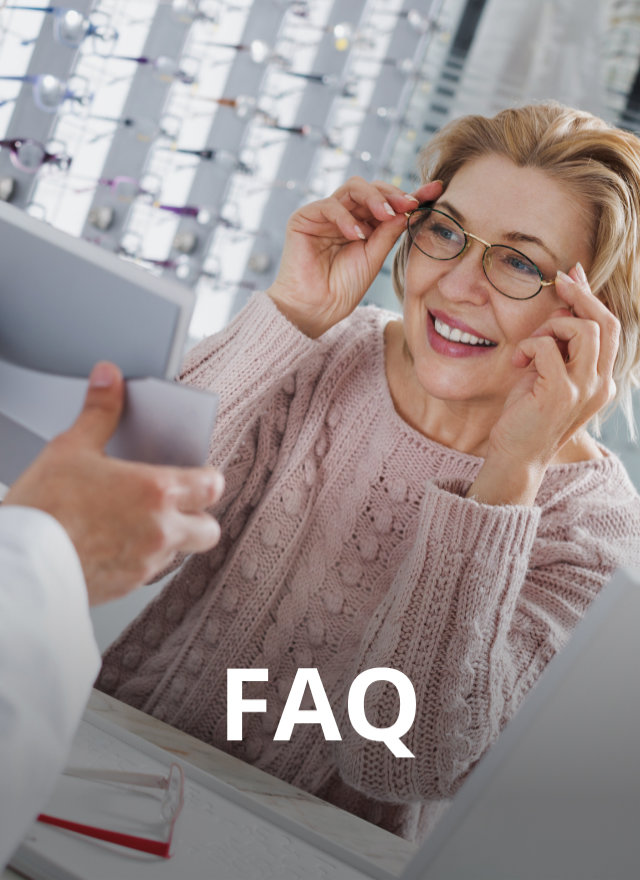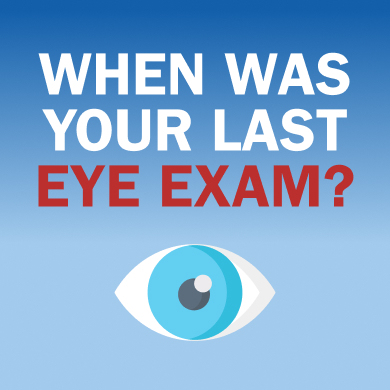

Answers About Your Vision
General Answers
Easy! Check our Store Locator.
The American Optometric Association recommends annual exams.
Your eye doctor will check a number of things. When you read an eye chart, your doctor determines your visual acuity, assigning a value to each eye. For example, perfect vision is 20/20 while 20/40 requires vision correction through glasses or contact lenses.
During the exam, your vision professional will dilate your pupils with eye drops. This will give them and their instruments a better view to check the internal health of your eyes.
They will also test for glaucoma, a disease that increases the pressure inside your eyeball and, in advanced cases, can cause vision loss.
After these tests, your doctor may continue with additional tests depending on what they find.
Normal results mean your eye doctor found no problems, that your vision is 20/20, or can be corrected to 20/20 with corrective lenses. It means you can see colors, and you show no signs of cataracts or glaucoma.
Results considered abnormal may include a range of diagnoses:
- Astigmatism: A condition in which two unequal, opposite meridians of the eye produce two different focal lengths and blurred vision. This is commonly referred to as a variance of your “base curve” or eye shape.
- Blocked Tear Duct: A blockage in the tube that carries excess tears from the eye.
- Cataracts: A clouding of the eye lens which decreases visual clarity.
- Color Blindness: The inability to distinguish certain colors.
- Optical Damage: Injury to the eye, blood vessels, optic nerve or fundus.
- Glaucoma: A disease in which pressure rises inside the eyeball, damaging the optic disk, causing gradual vision loss.
- Hyperopia: Farsightedness, the ability to see distant objects more clearly than nearby objects.
- Strabismus: Commonly called “lazy eye,” the condition in which one eye is able to fixate on a subject, but the other eye drifts in another direction because of a weaker eye muscle.
- Myopia: Nearsightedness, the ability to see nearby objects more clearly than objects that are far away.
- Presbyopia: A condition due to aging which diminishes visual accommodation; often requires using bifocals for clear near vision (reading).
Of course you can! We want you to be free to choose the doctor you like most. We are here for you if you need an exam but will also accept all valid prescriptions from other doctors.
Examine the structure of your face. The right eyeglass frame should be in scale with the size of your face and contrast the shape. For example, if you have a round face, consider frames that are narrower and more elongated.

Also, pick a frame that compliments or highlights your best facial feature.
Your Meijer Optical store has a full range of lens types to match your prescription. Additionally, you’ll choose from a number of lens materials and coatings to suit your needs. Learn more.
Your eyewear includes a 30-day warranty against manufacturer defects. You may also opt to purchase our one-year Eyewear Protection Plan (EPP), which includes an additional layer of protection for a small fee. The EPP covers replacement for unexpected changes in Rx for the first 6 months, breakage protection for things like scratched lenses, and a one-time benefit to replace lost or stolen glasses. Associated co-pays apply. Ask an optician for more details.
Yes, we’ll refit and adjust your eyewear at no charge!
At Meijer Optical, our number-one job is taking care of you. If you aren’t happy with your purchase, please call or visit your local store so that we can figure out the best way to meet your needs.
We know how personal your eyewear is. We find that touching, feeling and trying on your new eyeglasses in person is always the best option. Plus, our opticians can counsel you on what styles are the best fit with your prescription needs and budget.
Our online selection is only a cross-section of our in-store assortment. We encourage you to visit a Meijer Optical store to see our latest collections and styles.
Hours vary from location to location. Please call ahead before visiting a store. You can find the location nearest you with our Store Locator.
For out-of-pocket expenses not covered by insurance, we accept cash, check, debit card or credit card. All locations accept Visa, MasterCard, Discover, American Express and Care Credit.
Answers about Contact Lenses
Today, almost anyone can wear contact lenses, even those with astigmatism. Your optometrist will recommend the right type to correct your vision:
- Disposable Lenses: Available for single-use or worn for 1-2 weeks; ideal for those with busy lifestyles.
- Extended Wear Lenses: Designed to be worn even as you sleep; continuous wear ranging from 24 hours to 1 month.
- Colored Lenses: Available as prescription or non-prescription cosmetic lenses; available in a range of colors to change or enhance your eye color.
- Toric Lenses: Specifically for those with astigmatism.
- Bifocal Lenses: Designed for those who need reading glasses, each lens has two areas, one for distant viewing and another for near viewing.
- Monovision Lenses: Alternative solution for those who need readers; one lens is fitted for distant viewing and the other is fitted for close-up.
- Gas Permeable Lenses: Rigid, oxygen-permeable lenses made from hard plastic and silicone; ask your optometrist if they are right for you.
It’s not necessary, but it’s a good idea, even if you wear contacts daily. Keeping a pair of eyeglasses as a backup can be a lifesaver if your eyes are irritated, injured or infected – or even in case you lose or run out of contacts. Also, even if you typically wear contacts, you may want a pair of prescription sunglasses or computer eyeglasses for particular situations. If you have questions, one of our opticians can help walk you through all the things to consider.
Everyone’s eyes are different shapes and sizes. Even your own two eyes are probably not exactly alike. Before writing a prescription for contacts, your eye doctor will measure the curvature of your eye and prescribe the right power, type and brand of contact lenses that will work best for you. This will ensure you get the most comfortable, safest lenses for you.
Possibly. Your optometrist can tell for sure.
Before altering your process or lens care products, consult with your eye care professional. Sometimes, even mixing two different, approved cleaning solutions can cause issues.
Many eye drops are specifically developed for use with contacts. Always make sure yours are recommended for this use before application. Check with your doctor or the product manufacturer for additional information.
Never wear lenses that have passed the expiration date printed on the package.
No. Your lenses should be stored, cleaned and rewet only in sterile environments. Use only the lens care products your doctor recommends.
Yes. In fact, many athletes prefer contact lenses over eyeglasses. They provide sharp, clear vision, and they won’t fall off, break or fog up. Also, wearing protective goggles over contact lenses is a snap.
Possibly. Many contact lenses have been developed for extended wear and can be worn while you sleep. Ask your doctor if any of these are right for you.
No, it is not possible to lose a contact lens in your eye, though it may become displaced.
No. Your contact lenses are medical devices fitted for the shapes and sizes of your individual eyes.
Certainly! Even if you don’t require vision correction, we have contact lenses to change or enhance your eye color. To order them, you’ll need a contact lens exam with an eye doctor who will write a prescription for the right lens shapes and sizes for you. Keep in mind that the same care and cleaning instructions apply for both prescription and non-prescription lenses.

